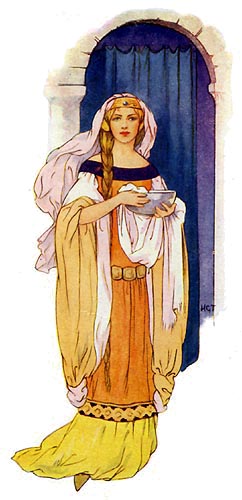 http://www.earlybritishkingdoms.com/bios/guinever.html(Born c.AD 490)(Welsh: Gwenhwyfar; Latin: Wenebara; English: Jennifer)
http://www.earlybritishkingdoms.com/bios/guinever.html(Born c.AD 490)(Welsh: Gwenhwyfar; Latin: Wenebara; English: Jennifer)
According to Sir Thomas Malory, King Arthur's wife, Guinevere, was the daughter of King Leodegrance of Cameliard (possibly Maelienydd in South-East Wales). His name comes from the Welsh, Lleudd-Ogrfan, for the traditions of that country call this man Ogrfan Gawr (Ogrfan the Giant) and locate his residences at Oswestry and Castell y Cnwclas (Knucklas Castle). Although, Geoffrey of Monmouth does not give him a name, he claims he was a Roman nobleman and that Guinevere was raised in the house of Cador, Earl of Cornwall.
One of the most beautiful maidens in Britain, Guinevere is usually depicted as meeting King Arthur after he helped expel King Ryonsfrom her father's kingdom. Naturally he fell in love with her at once and the two married soon afterward. They were given the Round Table as a wedding present by her father. In some accounts, they had a son namedSir Loholt.
Guinevere often appears in the Arthurian legends as the victim of abduction, a theme which is sometimes linked with a deified aspect of her origins. Her abductor is usually, Sir Meleagant (earlier known as King Melwas) who takes her to his stronghold at Glastonbury. She appears on the Modena Archivolt being rescued by Arthur and Gawain. Another early version has Arthur rescue her, aided by St. Gildas. However, in the most popular version, it is Sir Lancelot who is the hero of the day.
From the time of Geoffrey of Monmouth, Guinevere appears to have been something of a traitress, for he implies that she was a willing participant in Sir Mordred's rebellion; although the earlier Welsh Triads tell an otherwise unknown story that the Battle of Camlann at the climax of this conflict was caused by Mordred raiding Arthur's court and striking his Queen. Chrétien de Troyes mentions her infidelity, but it was the 13th century Vulgate Cycle of Arthurian tales, followed by Malory, which turned her into something of a latter-day Jezebel. She began a passionate affair with the young Sir Lancelot upon his arrival at court and yet banished him twice when she thought he had been deliberately unfaithful to her. Morgan le Fay discovered the affair, but failed in her attempts to warn Arthur. It was left to Sir Mordred to reveal the two lovers in flagrante delicto, an event which led to Guinevere being sentenced to burning at the stake. She was rescued by Lancelot, but captured by Mordred when Arthur pursued her lover abroad. As already indicated, in less sympathetic versions of the story, she was not sorry and even bore Mordred two children.
She is usually said to have spent the latter days of her life in a nunnery at either Caerleon or Amesbury. A particularly horrible version has her slain by Lancelot and entombed with Mordred who is forced to turn cannibal before he dies of starvation. In Scotland, Hector Boece recorded that she died a prisoner of Mordred's followers at Barry Hill in Strathmore. Local tradition adds that she was eventually torn to pieces by dogs and was buried at Meigle where her memorial can still be seen today. However she met her end, Guinevere's body is claimed to have made its way to join Arthur at Glastonbury Abbey. According to Giraldus Cambrensis, her body was found alongside him when the monks discovered his grave in 1191.
Although not mentioned by other writers, Giraldus goes on to tell how the inscription on the famous leaden burial cross, found there, recorded Guinevere as Arthur's 'second wife'. This may echo the story of the lady's half-sister, Guinevere the False (alias Guinevack), born to Leodegrance's lover on the same night as Guinivere. At one point she is said to have managed to exile the Queen and take her place. Alternatively, the Welsh Triads claim that Arthur was married, not twice, but three times, to ladies all named Guinevere: Gwenhwyfar daughter of Cywryd, Gwenhwyfar daughter of Gwythyr ap Greidiol and Gwenhwyfar daughter of Ogrfan Gawr. This may be due to confusion over his wife's parentage or indicate further the lady's origins in Celtic mythology, possibly as a triple aspect goddess.
No comments:
Post a Comment